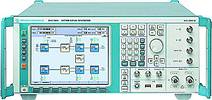

Rohde & Schwarz is offering its new high-end Vector Signal Generator R&S SMU200A. Besides high signal quality and flexibility, the R&S SMU200A has a revolutionary device and operating concept. The signal generator is of two-path design and thus provides two instruments in one. Applications that used to require two signal generators can in most cases now be handled by one instrument.
An innovative type of GUI on the large colour display facilitates work and makes it easier to understand the signal flow. Its makers believe that the instrument, with its wide range of features, is set to redefine the high-end market segment of signal generators.
Modern measurement tasks are becoming more and more complex and thus require greater flexibility of test and measurement equipment. The new Vector Signal Generator R&S SMU200A meets this requirement. It can be used in development, service and production, and provides maximum functionality while making operation as easy as possible.
The instrument can be equipped with two separate RF signal sources and two separate I/Q baseband signal sources. Not only does this save space but also makes it possible to generate two signals in parallel when performing complex measurements such as on base stations or mobile phones that comply with both the WCDMA and the GSM standard.
State-of-the-art chip technology enables the signal generator to compute complex signals in realtime. Consequently, the R&S SMU200A can generate the signals of all important mobile radio standards, such as GMS/EDGE and 3GPP FDD. It can also generate CW multicarrier signals as they are needed in amplifier tests. The instrument contains an arbitrary waveform generator (ARB) with a large memory depth. The effective memory depth is further increased by using a built-in hardware interpolation filter that makes low over-sampling values possible. Signals for WLAN 802.11 (a, b and g), cdma2000 and 3GPP TDD low rate and high rate can be generated for the R&S SMU200A by means of simulation software, WinIQSIM.
The high spectral purity with a single-sideband phase noise of typically -135 dBc, an ACLR of typically +70 dB with 3GPP and an I/Q modulator with 200 MHz RF bandwidth meet the highest demands and ultimately improve the quality of the developed or manufactured equipment. To optimise the signal generator for use in production during development, great importance was attached to high test and setting speed. The instrument has a frequency setting time of less than 3 ms, which accelerates test sequences in mass production and thus increases output. The new electronic attenuator operates wear-free throughout the entire frequency range (100 kHz to 6 GHz). The signal generator can be remote-controlled via the available GPIB and LAN interfaces - and a USB interface makes it easier to transfer data to the instrument.
For more information contact Charl Urquhart, Protea Communications & Measurement, 011 719 5703, c&[email protected], www.protea.co.za

© Technews Publishing (Pty) Ltd | All Rights Reserved